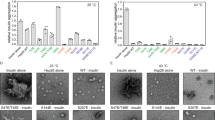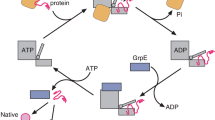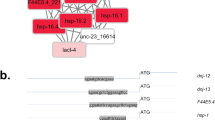Abstract
The human heat-shock factor (HSF) regulates heat-shock genes in response to elevated temperature1–6. When human cells are heated to 43 °C, HSF is modified post-translationally from a form that does not bind DNA to a form that binds to a specific sequence (the heat-shock element, HSE7,8) found upstream of heat-shock genes6. To investigate the transduction of the heat signal to HSF, and more generally, how mammalian cells respond at the molecular level to environmental stimuli, we have developed a cell-free system that exhibits heat-induced activation of human HSF in vitro. Comparison of HSF activation in vitro and in intact cells suggests that the response of human cells to heat shock involves at least two steps. First, an ATP-independent, heat-induced alteration of HSF allows it to bind the HSE; the temperature at which activation occurs in vitro implies that a human factor directly senses temperature. Second, HSF is phosphorylated. It is possible that similar multi-step activation mechanisms play a role in the response of eukaryotic cells to a variety of environmental stimuli, and that these mechanisms evolved to increase the range and flexibility of the response.
This is a preview of subscription content, access via your institution
Access options
Subscribe to this journal
Receive 51 print issues and online access
$199.00 per year
only $3.90 per issue
Buy this article
- Purchase on Springer Link
- Instant access to full article PDF
Prices may be subject to local taxes which are calculated during checkout
Similar content being viewed by others
References
Ritossa, F. M. Experimenlia 18, 571–572 (1962).
Nover, L. Heal Shock Response of Eukaryolic Cells (Springer, Berlin, 1984).
Craig, E. A. CRC Crit. Rev. Biochem. 18, 239–280 (1985).
Pelham, H. R. B. Trends Genet. 1, 31–35 (1985).
Lindquist, S. A. Rev. Biochem. 55, 1151–1191 (1986).
Kingston, R. E., Schuetz, T. J. & Larin, Z. Molec. cell. Biol. 7, 1530–1534 (1987).
Pelham, H. R. B. & Bienz, M. EMBO J. 1, 1473–1477 (1982).
Mirault, M.-E., Southgate, R. & Delwart, E. EMBO J. 1, 1279–1285 (1982).
Yamamoto, K. R. A. Rev. Genet. 19, 209–252 (1985).
Sen, R. & Baltimore, D. Cell 47, 921–928 (1986).
Prywes, R. & Roeder, R. G. Cell 47, 777–784 (1986).
Hayes, T. E., Kitchen, A. M. & Cochran, B. H. Proc. nat. Acad. Sci. U.S.A. 84, 1272–1276 (1987).
Zimarino, V. & Wu, C. Nature 327, 727–730 (1987).
Seguin, C. & Hamer, D. H. Science 235, 1383–1387 (1987).
Baeuerle, P. A. & Baltimore, D. Cell 53, 211–217 (1988).
Sorger, P. K., Lewis, M. J. & Pelham, H. R. B. Nature 329, 81–84 (1987).
Dignam, J. D., Lebovitz, R. M. & Roeder, R. G. Nucleic Acids Res. 11, 1475–1589 (1983).
Fried, M. & Crothcrs, D. M. Nucleic Acids Res. 9, 6505–6525 (1981).
Siebenlist, U. & Gilbert, W. Proc. natn. Acad. Sci. U.S.A. 77, 122–126 (1980).
Gilman, M. Z., Wilson, R. N. & Weinberg, R. A. Molec. cell. Biol. 6, 4305–4316 (1986).
Anantham, J., Goldberg, A. L. & Voellmy, R. Science 232, 522–524 (1986).
Finley, D., Ciechanover, A. & Varshavsky, A. Cell 37, 43–55 (1984).
Golf, S. A. & Goldberg, A. L. Cell 41, 587–595 (1985).
Munro, S. & Pelham, H. Nature 317, 477–478 (1985).
Wu, C. et al. Science 238, 1247–1253 (1987).
Verjee, Z. H. M. Eur. J. Biochem. 9, 439–444 (1969).
Beckwith, J. & Zipser, D. The lactose operon (Cold Spring Harbor, New York, 1970).
Wurm, F. M., Gwinn, K. A. & Kingston, R. E. Proc. natn. Acad. Sci. U.S.A. 83, 5415–5418 (1986).
Holmgren, R., Livak, K., Morimoto, R., Freund, R. & Meselson, M. Cell 18, 1359–1370 (1979).
Author information
Authors and Affiliations
Rights and permissions
About this article
Cite this article
Larson, J., Schuetz, T. & Kingston, R. Activation in vitro of sequence-specific DNA binding by a human regulatory factor. Nature 335, 372–375 (1988). https://doi.org/10.1038/335372a0
Received:
Accepted:
Issue Date:
DOI: https://doi.org/10.1038/335372a0
This article is cited by
-
Overexpression of PeHSF mediates leaf ROS homeostasis in transgenic tobacco lines grown under salt stress conditions
Plant Cell, Tissue and Organ Culture (PCTOC) (2013)
-
Stress–inducible responses and heat shock proteins: New pharmacologic targets for cytoprotection
Nature Biotechnology (1998)
-
Biochemical events in the activation and attenuation of the heat shock transcriptional response
Journal of Biosciences (1998)
Comments
By submitting a comment you agree to abide by our Terms and Community Guidelines. If you find something abusive or that does not comply with our terms or guidelines please flag it as inappropriate.



